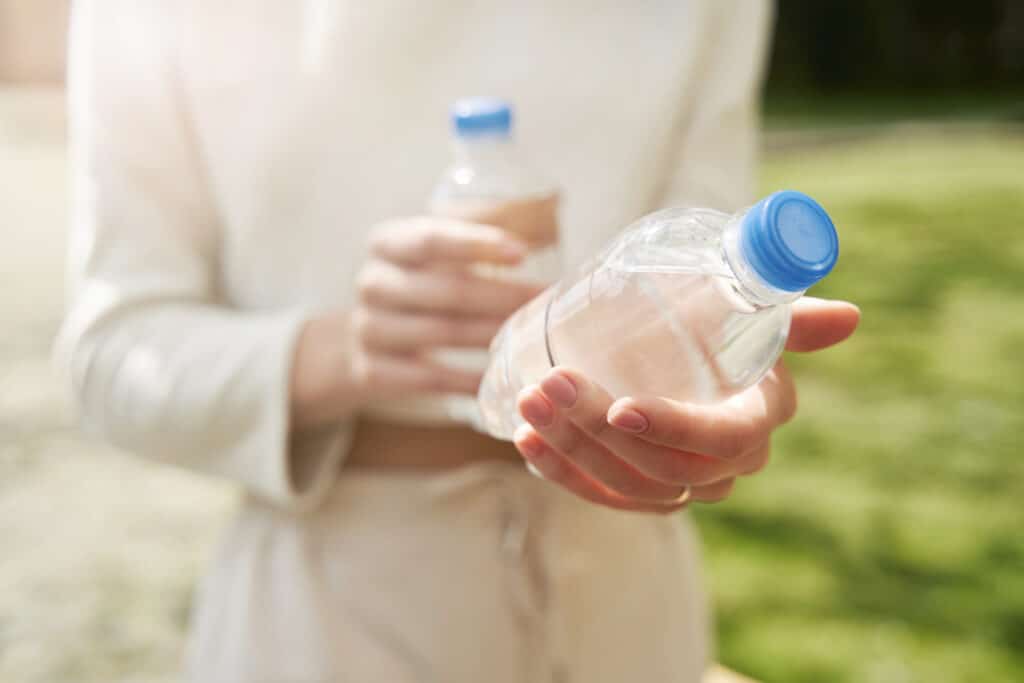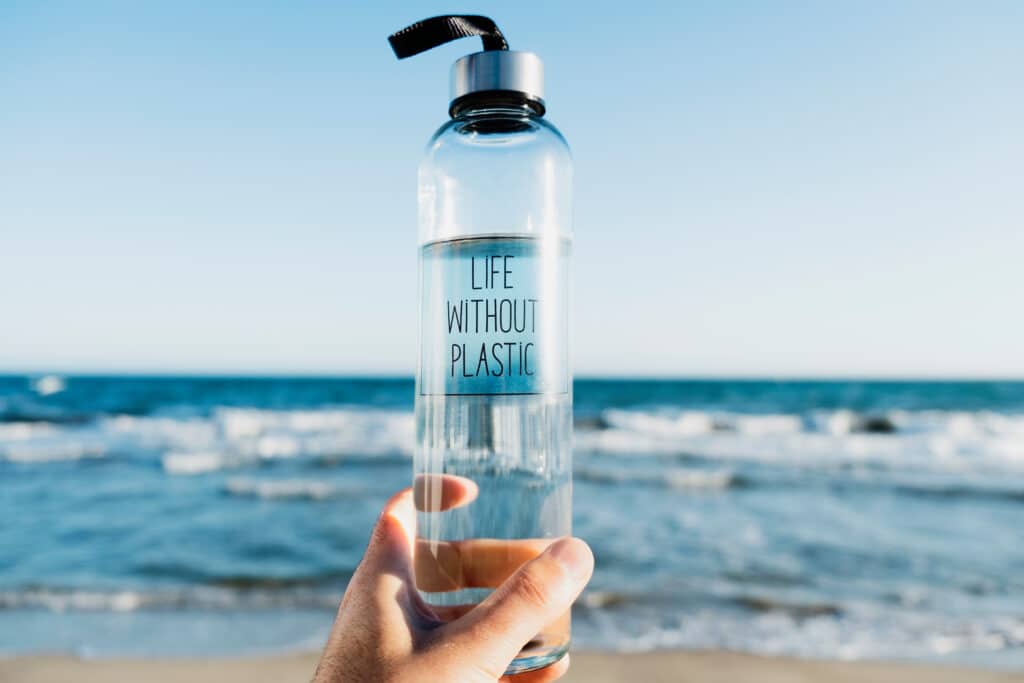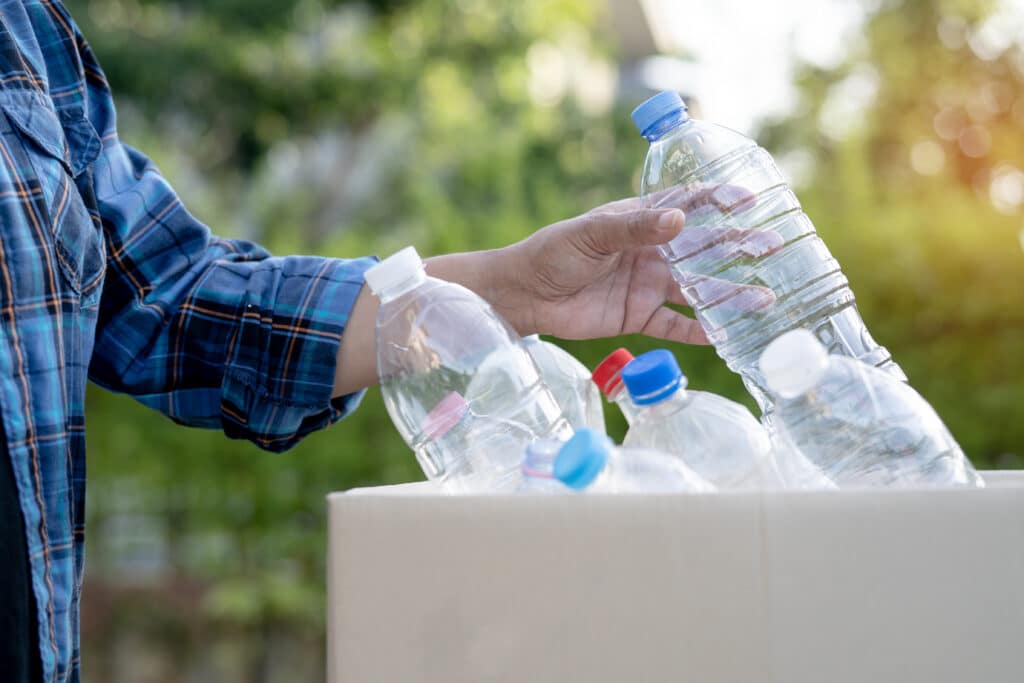The convenience of plastic comes at a cost, especially in the form of microplastics—tiny fragments that infiltrate our food, air, and water.
These plastics in the body pose significant health risks. They absorb environmental toxins and enter the food chain, leading to inflammation, oxidative stress, and chronic conditions like cardiovascular diseases and cancer.
Older adults are particularly vulnerable due to declining physiological functions, and even smaller nanoplastics present additional health risks by more easily infiltrating living cells.
While avoiding microplastics entirely may seem daunting, steps like avoiding single-use plastics, opting for natural fibers, and filtering water can help. Education and awareness are crucial to mitigating these risks.
Read on to explore what microplastics are, how they impact your health, and practical steps you can take to minimize their presence in your life.
What Exactly Are Microplastics?
Plastics have a somewhat complex lifecycle. As soon as plastic products are produced, they degrade into microplastics.
By definition, microplastics are solid, synthetic particles up to 5mm in size. They can enter our bodies just as quickly and undetected as a virus would, making it almost impossible to know how much we’ve been exposed to them.
There are many sources of microplastics. These can include larger plastics that eventually break down into smaller pieces or be manufactured specifically for use in other products.
From cosmetics and detergents to paint and synthetic fabrics, you’ll find microplastics in many products you use daily.
Microplastics can absorb toxins from the environment during their lifetime, and when marine life ingests these particles, those same toxins can end up in the food we eat and the water we drink.
Because they’re so small and hard to detect, they can be ingested easily by animals and humans, which can lead to health concerns as they accumulate.
How Do Microplastics Affect Our Health?

As we learn more about how microplastics affect our health, it becomes clear that these tiny particles have a serious impact, especially as we age.
Though the research is still new and evolving, studies have found that microplastics can lead to inflammation and oxidative stress, both of which are risk factors for chronic conditions like cardiovascular diseases or cancer.
Clinical studies show that microplastics are present in human organs and tissues, and when they accumulate, they can lead to health complications.
Studies have also found that microplastics can cross the blood-brain barrier, which has the potential to cause neurological damage.
How Are Microplastics Detected in the Body?
Microplastics are detected through a new and complex blood testing process called double-shot pyrolysis gas chromatography/mass spectrometry.
While the name is a mouthful, the process is relatively straightforward: blood samples are heated, which allows the tester to separate the organic compounds from the non-organic ones. The tester can then determine the quantity of plastic in each sample.
This is a complex process, so it is not widely available to the public. However, you can avoid consuming plastics without worrying about being tested.
Side Effects of Excessive Plastics in the Body

Microplastics are more than just an environmental pollutant; they’re a growing health concern. Here’s a more in-depth look at some of the potential risks of exposure:
Oxidative Stress and Inflammation
The inflammation and oxidative stress in your body caused by the presence of microplastics can lead to cellular damage and contribute to diseases like cancer, cardiovascular diseases, and neurodegenerative disorders.
Hormone Changes
Most plastics contain chemicals that can disrupt your endocrine systems, leading to reproductive issues, neurodevelopmental problems in children, and metabolic disorders.
Organ Damage
Chemicals known as carcinogens and neurotoxins are commonly found in plastics. These can cause direct damage to organs and disrupt their function, leading to diseases over time.
Cardiovascular Problems
Recent research suggests that microplastics found in our blood vessels can increase the risk of stroke, heart attack, or death.
Genotoxicity
The destruction or alteration of genetic material within a cell is called genotoxicity. Microplastics can lead to these cellular changes, leading to mutations that can cause cancer.
Respiratory Problems
Studies have shown that inhaling microplastics can lead to severe health conditions, such as lung disease.
Cognitive and Developmental Effects
Early births, low birth weights, and problems with brain development have all been linked to exposure to plastic-related chemicals. These can also affect hormone activity, disrupting children’s growth and cognitive function.
These findings show how important it is that we continue to research and understand the extent of the health risks associated with plastic exposure.
Health Risks for Older Adults

As we age, our bodies naturally lose the ability to repair and regenerate, and we become more susceptible to the negative consequences of exposure to environmental pollutants like microplastics.
We’re still learning about the ways microplastics can affect the aging process. Still, studies consistently show adverse outcomes of exposure to these particles, especially when they accumulate in our bodies. Here are some examples:
- Older adults may be more at risk of the effects of microplastics because of the natural decline in our body’s physiological functions and how well we can get rid of toxins.
- Inflammatory diseases are more common in older populations, and microplastic exposure can contribute to or worsen these conditions.
- Cardiovascular risks, such as heart attacks and strokes, have been associated with the presence of microplastics in the body. These conditions are already a significant concern for older adults.
- Microplastics can accelerate the aging of cells and tissues, contributing to premature aging in several organ systems.
- Microplastics may pick up other toxins during their lifespan and increase toxicity over time. This may significantly affect older individuals because they accumulate in their systems over time.
- Genotoxicity, or the destruction or alteration of genetic material in a cell, has been linked to microplastics in our bodies and can lead to age-related diseases.
It’s important to remember that the research is ongoing, so the full health implications of microplastics for aging are still being uncovered.
However, our evidence is clear: reducing exposure to microplastics can help protect the health of older adults from the risks associated with microplastics in our bodies.
What Are Nanoplastics?
So, we know that microplastics are a growing threat to our health and environment, but what are nanoplastics, and are they less of a concern? Unfortunately, the answer is no.
Nanoplastics are often considered a subcategory of microplastics. They’re extremely tiny particles of plastic less than 1 micrometer (that’s 1000 nanometers) in size. They’re so small and invisible to the naked eye that even a standard microscope isn’t strong enough to see them.
Like microplastics, nanoplastics can originate from larger plastics that degrade over time or be manufactured for use in products such as cosmetics, pharmaceuticals, fertilizer, and countless others.
Heat exposure or mechanical stress can also release nanoplastics from plastic products like water bottles.
Because of their tiny size, nanoplastics are easily ingested, absorbed, and inhaled by humans and animals. This ability to infiltrate our lives without our knowledge raises enormous concerns for the long-term health of younger populations and older generations who have accumulated these microscopic particles in their systems over the years.
Nanoplastics and Aging
The effects of nanoplastics on the aging process are similar to those of microplastics. For example, nanoplastics found in blood vessels have been linked to an increased risk of heart attack, stroke, and even death.
These tiny particles have the potential to cause more damage than microplastics because they’re so small that they can more easily be absorbed into living cells.
Plus, the breakdown into tiny particles over time leads to more particles, allowing them to spread even more easily.
Nanoplastics have been found to have a significant effect on the aging process. They can contribute to or worsen many health conditions in older adults. In addition to the risks listed above, nanoplastics can also cause:
Heart aging and additional stress on heart cells can lead to cardiovascular diseases. This cellular aging induced by nanoplastics has the potential to lead to premature aging of the heart and other tissues.
Neurological conditions such as Parkinson’s disease and dementia have been linked to nanoplastic exposure. This is because nanoplastics can affect specific brain proteins related to these conditions.
These findings underscore the importance of continued research on the effects of nanoplastic exposure on the aging process. Understanding the extent of these risks is essential to develop protective strategies and reduce the potential harm of these invisible particles.
Strategies to Reduce Plastic Exposure

It may feel like you’re entirely surrounded by micro- and nanoplastics, and there’s no hope of avoiding them.
Still, there are, in fact, ways to reduce your exposure to plastics and their negative impact on your health.
Lifestyle changes are the most effective way to reduce exposure to harmful plastic particles. Here are some tips to reduce the amount of plastic in your life:
- Avoid single-use plastic products. Opt for a stainless steel water bottle instead of a single-use plastic bottle. Glass containers are also good for food storage, especially when reheating.
- Go for natural fibers like organic cotton, bamboo, and hemp. These fibers don’t contain microplastics.
- Avoid synthetic fibers like polyester, acrylic, and polyamide. These fabrics are plastic and can break off and shed microplastics when washed.
- Avoid plastic-containing cosmetics. Opt for cosmetics that don’t contain microbeads.
- Filter your water. Many at-home water filters can eliminate microplastics from the water you drink.
- Eat less shellfish. When they eat, shellfish filter a lot of water from the ocean, so it’s easier for them to accumulate more microplastics than other seafood.
- Use an air filter to reduce the microplastics you inhale at home.
While it may not be very convenient, staying informed, minimizing your contact with microplastics, and reducing their risks can pay off in the long run.
Remember, there’s no specific treatment for microplastic exposure, but staying on top of your health and monitoring potential health issues related to plastic exposure can help you catch any problems early on.
The Big Picture of Microplastics
The use of plastic products in our modern lives is overwhelming, but it’s not all bad. Some of these products are necessary for medical procedures and scientific advancements.
Still, the consequences of plastic on our bodies and the environment can’t be ignored. Education and awareness are the key to understanding the risks and what you can do to protect yourself and your loved ones from plastic exposure.
Key Takeaways
- Microplastics, tiny plastic fragments from degrading larger plastics or manufactured products, infiltrate our bodies through food, air, and water, posing significant health risks, especially for older adults.
- Common sources include cosmetics, detergents, paint, and synthetic fabrics, which absorb environmental toxins and enter the food chain.
- Research shows microplastics cause inflammation and oxidative stress and can cross the blood-brain barrier, contributing to chronic conditions like cardiovascular diseases, cancer, and neurological damage.
- Excessive exposure leads to hormone disruption, organ damage, cardiovascular issues, genotoxicity, respiratory problems, and cognitive effects, with older adults being more vulnerable due to declining physiological functions.
- Nanoplastics, even smaller than microplastics, infiltrate living cells more readily, posing additional health risks.
- Reducing exposure involves avoiding single-use plastics, choosing natural fibers, avoiding synthetic fibers and plastic-containing cosmetics, filtering water, eating less shellfish, and using air filters.
- Education and awareness are key to understanding and mitigating plastic exposure risks, as no specific treatment exists.
References
- Leslie, Heather A et al. “Discovery and quantification of plastic particle pollution in human blood.” Environment international vol. 163 (2022): 107199. doi:10.1016/j.envint.2022.107199
- Kopatz V, Wen K, Kovács T, Keimowitz AS, Pichler V, Widder J, Vethaak AD, Hollóczki O, Kenner L. Micro- and Nanoplastics Breach the Blood-Brain Barrier (BBB): Biomolecular Corona’s Role Revealed. Nanomaterials (Basel). 2023 Apr 19;13(8):1404. doi: 10.3390/nano13081404. PMID: 37110989; PMCID: PMC10141840.
- Plastic and Human Health: A Lifecycle Approach to Plastic Pollution – Center for International Environmental Law
- How Plastic Can Harm Your Health – Consumer Reports
- Yousefzadeh M, Henpita C, Vyas R, Soto-Palma C, Robbins P, Niedernhofer L. DNA damage-how and why we age? Elife. 2021 Jan 29;10:e62852. doi: 10.7554/eLife.62852. PMID: 33512317; PMCID: PMC7846274.
- Wang K, Du Y, Li P, Guan C, Zhou M, Wu L, Liu Z, Huang Z. Nanoplastics causes heart aging/myocardial cell senescence through the Ca2+/mtDNA/cGAS-STING signaling cascade. J Nanobiotechnology. 2024 Mar 6;22(1):96. doi: 10.1186/s12951-024-02375-x. PMID: 38448951; PMCID: PMC10918962.






